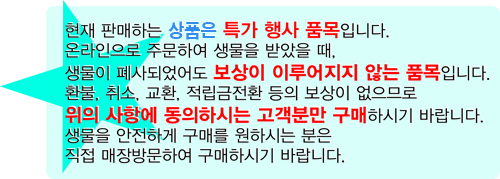|
CRS 크리스탈 레드 쉬림프 [A~SS급]
크기 : 1~1.5cm (생물은 크기와 발색의 차이가 있을 수 있습니다.)
암수 구분없이 랜덤으로 보내드립니다.
참고 : 발색에 민감하신 분은 구매를 자제해 주세요.
I am a hobby aquarist living in Nagoya, Japan. Below is a summary of my Japanese web page. On 1996/5/17, Japanese newspaper reported.
Mr. HISAYASU SUZUKI has succeeded in breeding true red bee shrimp. He has named the shrimp "Crystal Red" and has been awarded a patent for his new shrimp.
Mr, SUZUKI has been breeding normal bee shrimps, which are banded with black stripes and has spent more than 8 million yen developing methods for breeding them over the past 6 years. Three years ago, he notice a single red bee shrimp in a batch of about a thousand shrimp.
This first red bee shrimp died but three generations of bee shrimp later, he discovered 3 red bee shrimps among the 3,000 he had bred.
He was successful in breeding the 3 red bee shrimp and now has more than 8,000 red bee shrimp in his tanks.
Mr. SUZUKI is a master of a small SUSHI bar in Aichi, Japan.
The Crystal Red bee shrimp is truly red. It's color is just like that of boiled shrimp on Sushi rice.
#Above English is given from Justin P. Healy. (Than'x Justin !.)
How to keep CRS
Crystal Red shrimps & normal bee shrimps in my tank
Mr. SUZUKI told me how to keep Bee Shrimps healthy.
If you are beginner of your aquarium life, it is a little difficult for you to keep them alive.
If you already keep plants in your aquqrium, you can keep the shrimps healthy.
NO anmonia in the tank. It is fatal for them.
They need pure & clean water.
Normal bee shrimps are tough, but Crystal Red Shrimps are very sensitive.
PH6.2~7.2 temp 22~25
If the water shift to alkaline, it means Ammonium ion in the tank water has reduced to ammonia, So I recommand to keep the tank water a little acidis for them.
PH7.5 or over is dangerous for bee shrimps.
Small gravel is better for breeding them. (bare tank is no problem.)
Tetra P-1 or P-2 sponge filter is recommended.
Filteration is necessary. I use charcole & carbone filteration.
"EHIIM" style filteration is recommended. But I'm now using upper flow filteration for my 12 gal (45 litter) tank, with no problem.
You may renew 1/3 of the water in the tank a week.
Aqua Safe NH/CL Formula is recommended to remove chlorine & chloramine from tap water. Aqua Safe 2 in 1 is not necessary.
Chemical is not good for them.
Their life is about 15 month. To grow up to adult needs for 6 months. An adult Crystal Red spawns 20~30 babies every month.
If you find eggs under their bodies, you will see babies after 3 weeks.
Crystal Red is sure to be born in red. Adult Crystal Red is sure to give birth to red babies!
They may eat algae, but other food is recommended for them.
Fantinalis antipyretica/Riccia fluitans (a kind of moss) are good for them.
Boild spinach is their favorite. (They are POPYE?)
As soon as you put spinach in your tank, they will come to eat it.
You may treat to them one or two spinach every 3 days.
If they ignore spinach, It is a time to change water. (Bad water conditions)
<번역본>
CRS 크리스탈 레드 쉬림프

CRS를 유지하는 법
크리스탈 레드 쉬림프 & 노말 비 쉬림프
스즈키씨가 어떻게 비 쉬림프를 건강하게 유지할 수 있는지 저에게 얘기해 주었습니다.
만약 당신이 어항관리를 처음 하신다면, 비 쉬림프를 건강하게 키우는 것이 어려울 것입니다.
그렇지만 당신이 어항에 미리 수초를 키우고 있다면, 당신은 쉬림프를 건강하게 키울 수 있습니다.
암모니아가 어항에 없어야 합니다. 이는 쉬림프들에게 매우 치명적입니다.
그들에게 깨끗하고 청결한 물이 필요합니다.
Ph농도는 6.2 ~ 7.2가 적당하고 온도는 섭씨 22도 ~ 25도가 좋습니다.
만약 물이 알칼리성으로 변한다면, 이는 어항의 물이 암모니아성으로 바뀐다는 뜻이므로,
저는 약간의 산성인 상태의 물상태를 유지하는 것을 추천합니다.
Ph농도가 7.5 이상이 되면 비 쉬림프에게 위험합니다.
작은 자갈도 그들을 키우는데 더욱 좋습니다. (빈 어항도 상관없습니다)
테트라 P-1이나 P-2 필터를 추천합니다.
필터기는 중요합니다. 저는 숯 & 탄소 성분으로 된 필터기를 사용합니다.
'에하임' 스타일의 필터기를 추천합니다. 그러나 저는 현재 제 45리터 어항에 상류형 필터기를 문제없이 사용중입니다.
일주일에 한번은 어항의 물을 1/3을 갈아줘야 할것입니다.
염소와 클로라민을 제거하기 위해 아쿠아 세이프 NH/CL 포뮬라를 추천합니다. 아쿠아 세이프 2 in 1은 필요하지 않습니다.
화학성분은 쉬림프에게 좋지 않습니다.
쉬림프의 평균 수명은 약 15개월입니다. 어른이 되기 위해서는 6개월 정도가 필요합니다. 어른 크리스탈 레드 쉬림프는
20~30마리의 치어를 매달 낳습니다. 만약 쉬림프의 몸 아래쪽에서 알들을 발견한다면, 3주 이후에 치어를 볼 수 있습니다.
크리스탈 레드 쉬림프는 빨간색 자체로 태어납니다. 어른 크리스탈 레드 쉬림프가 빨간 아기들을 낳는거죠!
레드 쉬림프는 조류를 먹을 겁니다. 그러나 다른 사료는 추천하지 않습니다.
Fantinalis antipyretica/Riccia fluitans (이끼의 한 종류)가 좋습니다.
삶은 시금치가 그들이 가장 좋아하는 음식입니다. (쉬림프들은 뽀빠이?)
시금치를 어항에 넣어주자마자, 그들은 그것을 먹으러 달려들겁니다.
3일마다 1~2개의 시금치로 쉬림프들을 접대할 수 있습니다.
만약 그들이 시금치를 싫어한다면, 어항 물을 갈아줘야합니다. (나쁜 물 상태)
|